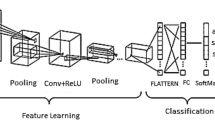Abstract
Lung cancer is a disease caused by abnormal lung cell growth. The number of people of all ages and sexes with lung tumors is constantly increasing. Classical classification of lung tumors can be sometimes misleading and time-consuming. Consequently, automated diagnosis is becoming a necessity to avoid the occurrence of errors and increase the survival rate of patients with lung tumors. However, deep learning and transfer learning are effective tools for the early detection and classification of lung tumors on the basis of anatomopathological slides of the lung. This work presents a Deep learning/Transfer learning implementation for lung tumor classification using a six-class database (LUAD, LUSC, SCLC, PTB, OP, NL). In order to reach the average accuracy of 98.9%, the implementation was trained using three convolutional neural network models: VGG19, ResNet50, and InceptionV3.
Access this chapter
Tax calculation will be finalised at checkout
Purchases are for personal use only
Similar content being viewed by others
References
Sung, H., et al.: Global cancer statistics 2020: GLOBOCAN estimates of incidence and mortality worldwide for 36 cancers in 185 countries. CA Cancer J. Clin. (2021). https://doi.org/10.3322/caac.21660
Barlesi, F., Mazieres, J., Merlio, J.-P., Debieuvre, D., Mosser, J., Lena, H., et al.: Routine molecular profiling of patients with advanced non-small-cell lung cancer: results of a 1-year nationwide programme of the French Cooperative Thoracic Intergroup (IFCT). Lancet 387(10026), 1415–1426 (2016)
Travis, W.D., Brambilla, E., Nicholson, A.G., Yatabe, Y., Austin, J.H.M., Beasley, M.B.: The 2015 World Health Organization classification of lung tumors. J. Thorac. Oncol. 10(9), 1243–1260 (2015)
Travis, W.D., Colby, T.V., Corrin, B., Shimosato, Y., Brambilla, E., Sobbin, L.H., et al.: Histological Typing of Lung and Pleural Tumours. Springer, Berlin (1999)
Bankhead, P., Loughrey, M.B., Fernández, J.A., Dombrowski, Y., McArt, D.G., Dunne, P.D., et al.: QuPath: open source software for digital pathology image analysis. Sci. Rep. 7, 16878 (2017)
Senaras, C., Niazi, M.K.K., Lozanski, G., Gurcan, M.N.: DeepFocus: detection of out-of-focus regions in whole slide digital images using deep learning. PLoS ONE 13, e205387 (2018)
Wang, S., Wang, T., Yang, L., Yang, D.M., Fujimoto, J., Yi, F., et al.: ConvPath: a software tool for lung adenocarcinoma digital pathological image analysis aided by a convolutional neural network. EBioMed. 50, 103–110 (2019)
Janowczyk, A., Zuo, R., Gilmore, H., Feldman, M., Madabhushi, A.: Histoqc: an open-source quality control tool for digital pathology slides. JCO Clin. Cancer Inform. 3, 1–7 (2019)
Zheng, Y., Jiang, Z., Zhang, H., Xie, F., Shi, J., Xue, C.: Adaptive color deconvolution for histological WSI normalization. Comput. Methods Prog. Biomed. 170, 107–120 (2019)
Coudray, N., Ocampo, P.S., Sakellaropoulos, T., Narula, N., Snuderl, M., Fenyö, D., et al.: Classification and mutation prediction from non-small cell lung cancer histopathology images using deep learning. Nat. Med. 24, 1559–1567 (2018)
Yu, K.H., Wang, F., Berry, G.J., Ré, C., Altman, R.B., Snyder, M., et al.: Classifying non-small cell lung cancer types and transcriptomic subtypes using convolutional neural networks. J. Am. Med. Inform. Assoc. 27, 757–769 (2020)
Gertych, A., Swiderska-Chadaj, Z., Ma, Z., Ing, N., Markiewicz, T., Cierniak, S., et al.: Convolutional neural networks can accurately distinguish four histologic growth patterns of lung adenocarcinoma in digital slides. Sci. Rep. 9, 1483 (2019)
Wei, J.W., Tafe, L.J., Linnik, Y.A., Vaickus, L.J., Tomita, N., Hassanpour, S.: Pathologist-level classification of histologic patterns on resected lung adenocarcinoma slides with deep neural networks. Sci. Rep. 9, 3358 (2019)
Kriegsmann, M., Haag, C., Weis, C.A., Steinbuss, G., Warth, A., Zgorzelski, C., et al.: Deep learning for the classification of small-cell and non-small-cell lung cancer. Cancers 12, 1604 (2020)
Yang, H., Chen, L., Cheng, Z., et al.: Deep learning-based six-type classifier for lung cancer and mimics from histopathological whole slide images: a retrospective study. BMC Med. 19, 80 (2021)
Travis, W.D.: The 2015 WHO classification of lung tumors. Pathologe 35(2), 188 (2014). https://doi.org/10.1007/s00292-014-1974-3
Simonyan, K., Zisserman, A.: Very deep convolutional networks for large-scale image recognition. In: Proceedings of the IEEE Conference on Computer Vision and Pattern Recognition (2015)
He, K., Zhang, X., Ren, S., Sun, J.: Deep residual learning for image recognition. In: Proceedings of the IEEE Conference on Computer Vision and Pattern Recognition (2015)
Szegedy, C., Liu, W., Jia, Y., et al.: Going deeper with convolutions. In: Proceedings of the IEEE Conference on Computer Vision and Pattern Recognition, pp. 1–9 (2015)
Author information
Authors and Affiliations
Corresponding author
Editor information
Editors and Affiliations
Rights and permissions
Copyright information
© 2022 Springer Nature Switzerland AG
About this paper
Cite this paper
Gasmi, M., Derdour, M., Gahmous, A. (2022). Transfer Learning for the Classification of Small-Cell and Non-small-Cell Lung Cancer. In: Bennour, A., Ensari, T., Kessentini, Y., Eom, S. (eds) Intelligent Systems and Pattern Recognition. ISPR 2022. Communications in Computer and Information Science, vol 1589. Springer, Cham. https://doi.org/10.1007/978-3-031-08277-1_28
Download citation
DOI: https://doi.org/10.1007/978-3-031-08277-1_28
Published:
Publisher Name: Springer, Cham
Print ISBN: 978-3-031-08276-4
Online ISBN: 978-3-031-08277-1
eBook Packages: Computer ScienceComputer Science (R0)




